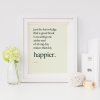Read:
Ebooks. It’s hard to believe that the e-book as we know it didn’t exist until 7 years ago. As Jason Matthews noted in Ebooks: What a Long Strange Trip on The Book Designer, Amazon didn’t launch the Kindle (and therefore the e-book market as we now know it) until 2007.
I still vividly remember sitting in on an editorial meeting at Simon & Schuster in 2009 and hearing the caution in the voices of editors as they discussed this new format. Back then the prognostications were big and bold (ebooks would take over the world and wreck all our lives!), but the numbers were tiny and insignificant. Ebooks were maybe 2-3 percent of the market–not a number anyone could really act on.
Between 2009 and 2012 we saw huge double-digit growth in the e-book market, and though we seem to be past the largest spike in e-book adoption, the market still grew from 23% to 27% of all book sales between 2012 and 2013.
What I wonder most: how will people read another 7 years from now? I don’t think this is an e-book vs. print book debate. I think it’s an e-book vs. print book vs. blogs vs. magazines vs. newspapers vs. online verticals vs. any other format, digital or print, where readers go for words.
As complex as the landscape is, we all want something very simple: to get our authors’ words in front of readers. I think that’s the only certainty we can cling to in these uncertain times.
So here’s hoping 2015 (and beyond!) will bring us even more ways to get writing to readers!
Eat:
Huge milestone alert! I finally, finally, finally (finally!) ate at Rose’s Luxury. It. Was. Incredible.
Which was a bit of a surprise, given that my expectations were sky-high. I’d first read about Rose’s in this article from August’s issue of Bon Appetit, when Andrew Knowlton named it the Best New Restaurant in America in 2014. So yes, I was expecting greatness.
And I am so happy that I was not disappointed. I can easily say it’s the best restaurant I’ve eaten at this year, and that the Pork Sausage, Habanero, and Lychee Salad was one of the best things I’ve eaten, ever.
But my very favorite moment of the night? Digging into the Cacio e Pepe Pasta and being absolutely floored by how something so simple can be so delicious. Granted, I have a soft spot for pasta, always and forever, but this? This was special. I would give all my worldly possessions to be able to know how they did it.

Cacio e Pepe Pasta from Rose’s Luxury. ‘Tis a thing of beauty. Source.
Oh, and there was also a Cinnamon Toast Crunch Ice Cream that blew our faces off. There was much moaning and gushing from our table that night!
Drink:
Kicking it over to Jarrett, our resident bartender, for a fun drink recipe:
The holidays are behind us, and you know what that means: taking stock of all the liquor left over from holiday parties. Some bottles you savor, like that glorious bottle of Bulleit Bourbon Uncle Bob gave you as a present. Others make you cringe, like that fifth of vanilla vodka your cousin’s girlfriend brought to New Years.
This year, I decided to come up with a plan for that nasty vanilla vodka once and for all by playing a fun game. It’s called: “figure out how to make a decent cocktail with disgustingly flavored alcohol” (FOHTMADCWDFA for short). Catchy, I know. But, in the end, I actually came up with a pretty good drink – we’ll call it the Apple Pie Cocktail.

Apple Pie Cocktail
• 2 lime slices
• One granny smith apple (for garnish)
• Two leaves of mint
• 3 oz. vanilla vodka
• Ginger ale
• Apple juice (we used honeycrisp apple juice, but regular works)
• Dash of cinnamon
Muddle lime slices and mint leaves in bottom of an old-fashioned glass. Fill glass half way with ice. Add vanilla vodka. Then fill remainder of glass with ginger ale and apple juice (2/3 ginger ale and 1/3 apple juice). Add a dash (around 1/8 teaspoon) of cinnamon. VERY briefly shake in a shaker (but only a shake or two because ginger ale carbonation will make it explode if shaken too much).
Using a paring knife or peeler, cut a strand of the granny smith skin off and add it as garnish. Imbibe and enjoy!








